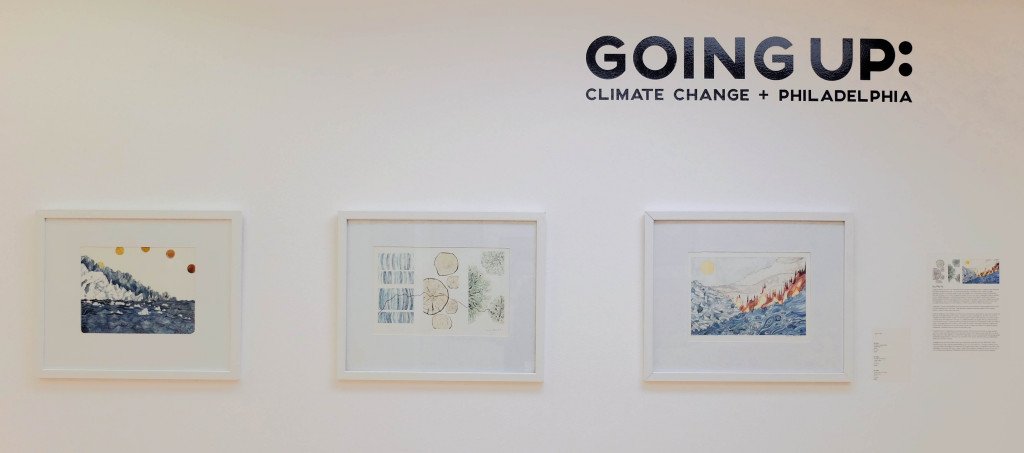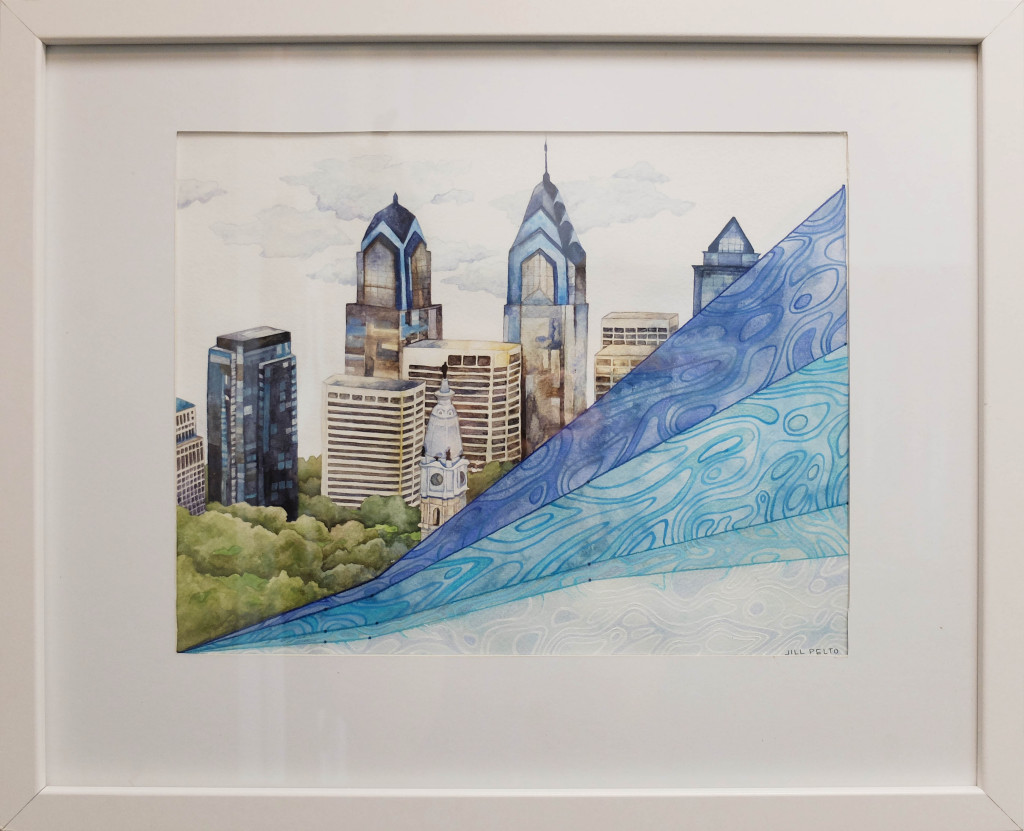By Christina Catanese, Director of Environmental Art
Looking back over the year of environmental art at the Schuylkill Center, one of the highlights of 2016 was our gallery show, Going Up: Climate Change + Philadelphia. Along with the work of seven other artists exploring the various facets of climate change, this show included a new work by Maine artist Jill Pelto which was created specially for this exhibition, called Philadelphia Sea Level Rise Scenarios.
Pelto herself is both an artist and a scientist, and uses her watercolor paintings to communicate scientific data in a more visually compelling way. Starting with data and charts as the framework for her paintings, she creates landscapes that enliven environmental information. For example, in Landscape of Change, Pelto uses the form of a line graph of declining glacier mass to depict a glacier, while a graph of rising sea levels is represented by deep blue water. Jagged red and orange imagery takes its shape from data on increasing forest fires, and increased atmospheric CO2 is shown as a gray sky.
In Going Up, we showed four of Pelto’s works that convey global data related to climate change, including her new work about sea level rise in our region.
Being an inland city, we don’t often think of sea level rise as something that will affect Philadelphia. But our two major rivers, the Schuylkill and the Delaware, are tidally connected to the ocean, meaning that sea level rise in the Atlantic has upstream impacts. Pelto pulled data from the Philadelphia Mayor’s Office of Sustainability report, Growing Stronger Toward a Climate Ready Philadelphia as the basis for her art work.
I asked Pelto to tell me more about her thinking behind the work she created for the Schuylkill Center.
“Philadelphia Sea Level Rise Scenarios shows four projections of sea level rise from 2000-2085. These possibilities from low to high are approximately: 12 in, 16 in, 36 in, and 54 in. I chose to make a piece about sea level rise because of the city’s proximity to the coast, and borders composed of the Delaware and Schuylkill Rivers makes it susceptible to the rising ocean, especially in concurrence with storm surges. Coastal cities globally are threatened by sea level rise, yet, in spite of these oncoming issues, Philadelphia is facing this certain future by educating and preparing.
I chose to represent an iconic view of the city skyline, with the sea level rise data superimposed on top. This composition allows the higher estimates of sea level rise to consume part of the city, literally communicating its vulnerability. But this piece isn’t meant to say that losing the city is inevitable: it shows that these different possibilities hinge on us, humanity. Philadelphia is determining what may happen to their city, and by doing so they learn how they can best prep for changes to come. In my artworks I like to depict reality, but I hope that for some viewers there is a takeaway of understanding what is to come, and all of our roles to help prevent and prepare.”
For me, Pelto takes data that we hear about or see presented regularly and brings it to life. How many times have we heard some permutation of the phrase “models project X feet of sea level rise by year Y,” and how often does it go in one ear and out the other as part of the information deluge of the digital age? Pelto provides a new way into understanding the same data, revealing the possibilities of environmental change through beautiful imagery that grounds us in what the data actually represent. Data become less inscrutable figures and abstract notions, and more directly connected to the real-world realities.
I find Pelto’s work to be a compelling example of a burgeoning generation of artists and scientists who hybridize their practices for enhanced impact. Scientists have established modes of communicating within the field and among peers, through line graphs, technical terminology, and peer-reviewed papers. Going outside of science is both challenging and necessary, with diverse tools needed to engage a broader audience in the latest science and predictions of future realities. Artists like Pelto, who ground themselves in science, have the ability to translate and reveal environmental data so it can be understood, and indeed felt, by more people than the environmental community.
See more of Pelto’s work here and more on Going Up here.


